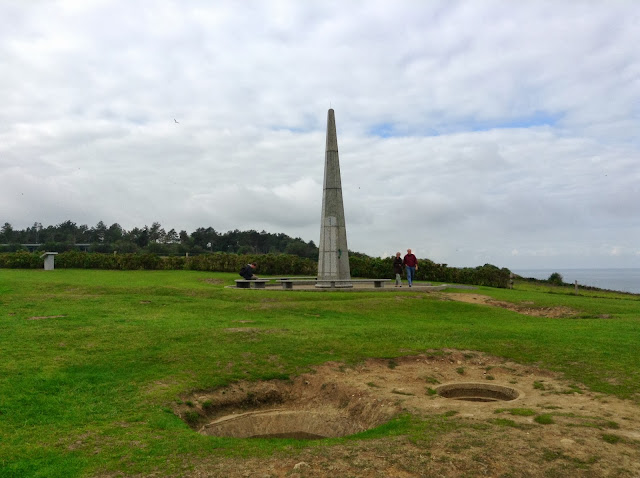On the 6th of June 1944, the United States infantry assaulted the German defensive system known as "The Atlantic Wall" at this beach in Normandy.
 |
| Omaha Beach |
The Allies assault on mainland Europe was planned for the date of the highest half-tide, forty minutes after first light and following a night when the moon rose between 1 and 2 am. Such occasions occur three times each month and in 1944 they occurred on the 5th, 6th and 7th of June.
 |
| Omaha Beach |
But the weather was appalling and the airborne and naval support strikes, planned for the 3rd and 4th of June, to clear the way for the infantry beach landings, had to be delayed. Almost at the point of turning the whole naval fleet back to England and waiting until the following month, General Eisenhower decided to risk a predicted slight improvement in the weather and the greatest assault in history took place here on 6th June 1944 - D-Day.
 |
| Memorial to the Ist Infantry Division, US Army - Omaha Beach |
By the end of the day of the sixth of June, here at Omaha Beach, the Americans had landed 34,500 men, of whom 2,000 died opposing the strong German defences in the blockhouses and dug-in batteries in the cliffs.
Bad weather had hampered the planned airborne and naval support and of the 2,400 tons of supplies that should have landed at Omaha to support the infantry, only 100 tons landed safely. Almost all of their artillery and most of their tanks, jeeps and trucks were engulfed by the sea.
Despite the heavy losses in both personnel and equipment, at the end of the day the American Infantry held a bridgehead 7km wide and 2km deep at this point.
There were five landing beaches - Utah and Omaha in the American Sector and Gold, Juno and Sword in the British and Canadian sector.
The British infantry landed at Gold beach with the objective of taking Bayeux, but they faced multiple difficulties - a beach enclosed and flanked by steep cliffs and a German gun battery.
The battery consisted of four, 152mm guns with a range of over 12 miles which could reach both Omaha and Gold beaches and ships at sea.
The bunkers were very well designed to resist impact and covered with earth. The range finding outpost was on the cliff edge, 300 yards ahead. The whole lot was defended by machine gun nests, barbed wire and mines.
During the night of the 5th June the Allies dropped 1,000 tons of bombs on the battery with accuracy but to no great effect. At dawn on 6th June, the battery engaged in an artillery dual with three Allied warships which continued for many hours. It then trained its guns on an infantry support ship which was badly damaged. Late in the evening another assault from the three Allied warships proved to be effective and by the morning of 7th June, British tropps occupied the battery.
 |
| Remains of the Mulberries at Gold Beach |
Pending the liberation and restoration of the main French harbours on the Normandy coast, Cherbourg, Le Havre and Rouen, the Allies had to create artificial roads, prefabricated quays and harbour installations on the days following D-Day. This was necessary to facilitate the gigantic effort of maintaing and reinforcing its land army.
Old merchant ships were sailed across the Channel and scuttled to form outer breakwaters offshore from Utah, Omaha, Gold, June and Sword beaches. These breakwaters were called Gooseberries.
 |
| Remains of the Mulberries at Gold Beach |
Offshore from Omaha and Gold beaches, chains of huge concrete caissons were sunk into position to form artificial quays and provide sheltered roads. Prefabricated in Great Britain and towed across the Channel, these units were sunk within 30 minutes by opening valves to let in the sea water. Within the breakwater constructed in this way, an ingenious system of floating quays, pontoon bridges, pontoon roadways etc allowed the rapid unloading of the transports ships tied up alongside. These structures were called Mulberries.
 |
| A floating quay |
During the great storm of the 19th June 1944, the two Mulberries were severely damaged and the small harbour at Omaha Beach completely wrecked and had to be abandoned. Only the Mulberry at Gold Beach was able to be restored to use during the following days. This storm seriously delayed planned tactics and actions. It took the Allies until 8th July to secure Normandy, to reinforce and regroup and begin their push towards the interior of France.
We know the rest.
There are 27 war cemetries in Normandy.
There are 13,800 American graves, 18,700 British graves, 5,000 Canadian, 650 Polish and 58,000 German graves.
These photos are from two British cemeteries. Disappointingly, the American cemetery was closed because of the current (October 2013) shutdown of government services in the US.
This material came from a booklet I purchased entitle D-Day and the Battle of Normandy, OREP Editions, Gerard Legout.










No comments:
Post a Comment